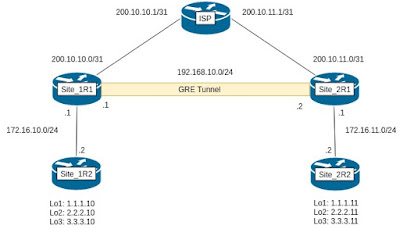As an Encapsulation protocol, GRE wraps the original packet (AKA as the Payload) in a GRE Header and add a new IP header (delivery header) is used to transport the packet over the GRE Tunnel. Once the packet arrives to the other end GRE removes the outer headers exposing the original packet.
The GRE Header defined in the RFC 2784 has a size of 64 bits (8 bytes) where the last 32 bits, commonly not used are optional and only present if the first bit of the first 32 bits is set to 1.
When using encapsulation protocols it is necessary to adjust the IP MTU and the TCP Maximum Segment Size to prevent fragmentation. As explained before GRE will add to the original packet a GRE Header (4 bytes) and an IP Header (20 bytes), adding up to an overhead total of 24 bytes, the overhead must be subtracted from the IP MTU value that must be set below the interface MTU value.
IP MTU (1500 bytes) - IP Header (20 bytes) - GRE Header (4 bytes) = 1476
To adjust the TCP Maximum Segment Size subtract from the interface MTU the following headers:
IP MTU (1500 bytes) - IP Header (20 bytes) - GRE Header (4 bytes) - IP Header (20 bytes) - TCP Header (20 bytes) = 1436
The following scenario shows how to configure a point-to-point GRE tunnel
initial config:
hostname ISP
!
interface GigabitEthernet0/0
ip address 200.10.10.1 255.255.255.254
!
interface GigabitEthernet0/1
ip address 200.10.11.1 255.255.255.254
!
hostname SitE_1R1
!
interface GigabitEthernet0/0
ip address 200.10.10.0 255.255.255.254
!
interface GigabitEthernet0/1
ip address 172.16.10.1 255.255.255.0
!
router ospf 100
network 172.16.10.1 0.0.0.0 area 0
!
ip route 0.0.0.0 0.0.0.0 200.10.10.1
!
hostname SitE_1R2
!
interface Loopback1
ip address 1.1.1.10 255.255.255.255
!
interface Loopback2
ip address 2.2.2.10 255.255.255.255
!
interface Loopback3
ip address 3.3.3.10 255.255.255.255
!
interface GigabitEthernet0/0
ip address 172.16.10.2 255.255.255.0
!
router ospf 100
network 1.1.1.10 0.0.0.0 area 0
network 2.2.2.10 0.0.0.0 area 0
network 3.3.3.10 0.0.0.0 area 0
network 172.16.10.2 0.0.0.0 area 0
!
hostname SitE_2R1
!
interface GigabitEthernet0/0
ip address 200.10.11.0 255.255.255.254
!
interface GigabitEthernet0/1
ip address 172.16.11.1 255.255.255.0
!
router ospf 100
network 172.16.11.1 0.0.0.0 area 0
!
ip route 0.0.0.0 0.0.0.0 200.10.11.1
!
hostname SitE_2R2
!
interface Loopback1
ip address 1.1.1.11 255.255.255.255
!
interface Loopback2
ip address 2.2.2.11 255.255.255.255
!
interface Loopback3
ip address 3.3.3.11 255.255.255.255
!
interface GigabitEthernet0/0
ip address 172.16.11.2 255.255.255.0
!
router ospf 100
network 1.1.1.11 0.0.0.0 area 0
network 2.2.2.11 0.0.0.0 area 0
network 3.3.3.11 0.0.0.0 area 0
network 172.16.11.2 0.0.0.0 area 0
!
tunnel config
hostname SitE_1R1
!
interface Tunnel100
ip address 192.168.10.1 255.255.255.252
ip mtu 1476
ip tcp adjust-mss 1436
tunnel source GigabitEthernet0/0
tunnel destination 200.10.11.0
!
router ospf 100
network 192.168.10.1 0.0.0.0 area 0
!
hostname SitE_2R1
!
interface Tunnel100
ip address 192.168.10.2 255.255.255.252
ip mtu 1476
ip tcp adjust-mss 1436
tunnel source GigabitEthernet0/0
tunnel destination 200.10.10.0
!
router ospf 100
network 192.168.10.2 0.0.0.0 area 0
!


